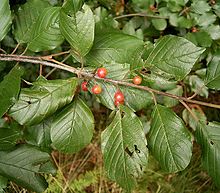Flora of New York/Rhamnaceae … Urticaceae
| ← Amygdaloideae 2 |
Flora of New York — Rosales: Rhamnaceae … Urticaceae | → Cucurbitales | |||
| Table of contents |
Genus index |
Protected species index | Invasive species index | ||
The first pair of Rosales families on this page (Rhamnaceae and Elaeagnaceae) contain several small trees and shrubs that are particularly invasive in many parts of New York. These include the autumn olive, Russian olive, common buckthorn, and glossy buckthorn.
Family Rhamnaceae
[edit | edit source]The Rhamnaceae (buckthorn family) in New York contains three species of native shrubs (two New Jersey tea and one buckthorn species). It also contains two highly invasive non-native buckthorns, both of which are prohibited in New York.[1][2]
|
Subfamily Rhamnoideae
[edit | edit source]Tribe Rhamneae
[edit | edit source]| Besides the two highly invasive exotic buckthorn species, the Rhamneae tribe contains the native alder-leaved buckthorn.
|
Rhamnus
[edit | edit source] The native alder-leaved buckthorn (Rhamnus alnifolia or Endotropis alnifolia)[1][2] should not be confused with the invasive exotic "glossy buckthorn" (Frangula alnus), which also goes by the similar common name "alder buckthorn." The two non-native buckthorns Rhamnus davurica and Rhamnus utilis have not been reported as naturalized in New York, but they have been reported outside of cultivation in neighboring states.
|
| Genus Rhamnus | Buckthorn | N.Y. Status | Images | Distribution | NY NPT |
L’Hér. 1789. Rhamnus alnifolius L’Hér.
1915. Apetlorhamnus alnifolia Nieuwl.
2016. Ventia alnifolia (L'Hér.) Hauenschild (superfl.)
2016. Endotropis alnifolia (L’Hér.) Hauenschild |
Alder-leaved buckthorn, American alder buckthorn, Dwarf alder, Swamp buckthorn Nerprun à feuilles d'aulne, Nerprun des marécages |
Native, CoC: 9, Likely secure OBL Perennial, Shrub, Part shade - shade |

|
NYFA: 4 |
USDA-NN Go Botany VASCAN ARS-GRIN ITIS Tropicos BONAP LBJ Images Wikispecies Note: source |
L. 1753. Rhamnus catharticus L. |
European buckthorn, Common buckthorn, Purging buckthorn, European waythorn Nerprun cathartique, Nerprun purgatif, Épine noire |
Introduced from Eurasia, n. Africa, Very highly invasive, NYIS: 80%[1], Invasive.org: [1], CP-2[2] NE-1[3], Prohibited[4], WW |

|
NYFA: X |
USDA-XX Go Botany VASCAN ARS-GRIN ITIS Tropicos BONAP Images Wikispecies |
| Genus Rhamnus (excluded taxa) | Buckthorn | N.Y. Status | Images | Distribution | NY NPT |
Pall. 1776. Rhamnus dauuricus Pall. 1866. R. catharticavar. dahurica Maxim. |
Dahurian buckthorn Nerprun de Daourie |
Introduced from Siberia, China, Japan, No specimens, CT, MA, PA, VT, PE |

|
NYFA: 0 |
USDA-XX Go Botany VASCAN ARS-GRIN ITIS Tropicos BONAP Images Wikispecies |
Decne. 1857. Rhamnus utilis Decne. |
Chinese buckthorn Vert de Chine |
Introduced from Asia, No specimens, Invasive.org: [2], CT, MI, OH, IN, IL |

|
NYFA: 0 |
USDA-X0 Go Botany ARS-GRIN ITIS Tropicos BONAP Images Wikispecies |
| |||||
Frangula
[edit | edit source]| Genus Frangula | Glossy buckthorn | N.Y. Status | Images | Distribution | NY NPT |
Mill. 1753. Rhamnus frangula L. 1768. Frangula alnus Mill. |
Glossy buckthorn, Glossy false buckthorn, Smooth buckthorn, Alder buckthorn |
Introduced from Eurasia, n. Africa, Highly invasive, NYIS: 73%[1], iMapInvasives, Invasive.org: [3], CP-2[2] NE-1[3], Prohibited[4], WW |

|
NYFA: X |
USDA-XX Go Botany ARS-GRIN Tropicos BONAP CABI Images Wikispecies |
Rhamnus caroliniana Walter
Rhamnus caroliniana var. mollis Fernald
|
Carolina buckthorn ⓘ
|
N. America native southern US, Not listed FAC Perennial, Tree-shrub |

|
iNat: Suffolk (2021) NYFA: iNat |
USDA-N0 Go Botany Images Wikispecies |
| |||||
Subfamily Ziziphoideae
[edit | edit source]Tribe Pomaderreae
[edit | edit source]Ceanothus
[edit | edit source] |
| Genus Ceanothus | New Jersey tea | N.Y. Status | Images | Distribution | NY NPT |
Ceanothus intermedius |
New Jersey tea, Indian tea, Wild snowball, Redroot, Snowbrush, Soapbloom, Mountainsweet |
Native, CoC: 7, Secure, S5-G5 Perennial, Shrub, Part shade — shade |

|
NYFA: 5 |
USDA-NNFS CS Go Botany LBJ Images Wikispecies |
| Jersey tea, Inland New Jersey tea, Prairie redroot, Grub root |
Native, Endangered Perennial, Shrub |

|
NYFA: 1 |
USDA-NN CS Go Botany LBJ Images Wikispecies | |
|
| |||||
Family Elaeagnaceae
[edit | edit source]The Elaeagnaceae (oleaster family)...[1]
|
Shepherdia
[edit | edit source]| Genus Shepherdia | Buffalo berry | N.Y. Status | Images | Distribution | NPT |
1753. Hippophae canadensis L.
1818. Shepherdia canadensis (L.) Nutt.
1890. Lepargyrea canadensis (L.) Greene
1935. Elaeagnus canadensis (L.) A. Nelson |
Canada buffalo-berry
Canada buffalo berry ⓘ
Russet buffaloberry ⓘ
Soapberry ⓘ
|
Native, CoC: 8, Likely secure, S4 UPL Perennial, Shrub |

|
NYFA: 4 iNat |
USDA-NN Go Botany Tropicos LBJ Images Wikispecies |
(Pursh) Nutt. 1813. Hippophae argentea Pursh 1818. Shepherdia argentea (Pursh) Nutt. 1890. Lepargyrea argentea (Pursh) Greene |
Silver buffalo-berry, Silver buffaloberry |
Introduced from w. N. America |

|
NYFA: X |
USDA-NN ARS-GRIN Images Wikispecies |
|
| |||||
Elaeagnus
[edit | edit source] Autumn olive has been shown to affect soil microbial communities even when it is present in relatively low densities.[1] |
| Genus Elaeagnus Hill | Silver-berry | N.Y. Status | Images | Distribution | NY NPT |
Thunb. 1784. Elaeagnus umbellata Thunb.
1784. E. crispa Thunb.
1836. E. parvifolia Wall. ex Royle
1909. E. umbellata var. parvifolia C.K.Schneid. |
Autumn olive, Autumn elaeagnus, Spreading oleaster Oléastre à ombelles, Chalef en ombelles |
Introduced from Asia, Very highly invasive, NYIS: 94%[1], Invasive.org: [4], CP-2[2] NE-1[3] |
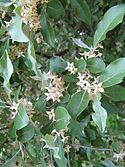
|
NYFA: X iNat |
USDA-XX Go Botany VASCAN ARS-GRIN Tropicos Images Wikispecies |
L. 1753. Elaeagnus angustifolia L.
1767. E. orientalis L.
1808. E. hortensis M.Bieb.
1857. E. moorcroftii Wall. ex Schltdl.
1887. E. angustifolia var. orientalis Kuntze |
Russian olive, Russian elaeagnus, Silver-berry, Oleaster, Trebizond-date Olivier de Bohême |
Introduced from Eurasia, Moderately invasive, NYIS: 68%[4], Invasive.org: [5], CP-5[5] NE-1[3] |

|
NYFA: X iNat |
USDA-XX Go Botany VASCAN ARS-GRIN ITIS Images Wikispecies |
Thunb. 1784. Elaeagnus multiflora Thunb. 1859. Elaeagnus longipes A.Gray |
Cherry silverberry, Cherry elaeagnus, Cherry oleaster Goumi |
Introduced from temperate Asia, Invasive.org: [6] |

|
NYFA: Livingston (1969) iNat: none (2021) NYFA: X iNat |
USDA-X0 VASCAN ARS-GRIN ITIS Images Wikispecies |
Thunb. 1784. Elaeagnus pungens Thunb. 1869. Elaeagnus simonii Carrière 1949. E. pungensvar. simonii Rehder |
Thorny-olive, Thorny elaeagnus, Spiny oleaster |
Introduced from China & Japan, No NY reports, Invasive.org: [7] |

|
iNat: Suffolk (2020) NYFA: 0 iNat |
USDA-X0 Go Botany ARS-GRIN ITIS Images Wikispecies |
Bernh. ex Rydb. 1814. Elaeagnus argentea Pursh (nom. illeg.) 1917. E. commutata Bernh. ex Rydb. 1955. E. veteris-castelli Lepage |
Silverberry, American silverberry, Wolf-willow Chalef argenté, Chalef changeant |
Introduced from western US, n. central US, Canada, N. America native, No NY reports |

|
iNat: Monroe (2020) NYFA: 0 iNat |
USDA-NN VASCAN ARS-GRIN ITIS Tropicos Images Wikispecies |
| |||||
Family Ulmaceae
[edit | edit source]The Ulmaceae (elm family)...[1]
Ulmus
[edit | edit source]| Genus Ulmus | Elm | N.Y. Status | Images | Distribution | NY NPT |
L. 1753. Ulmus americana L. 1860. U. americana var. aspera Chapm. 1860. U. floridana Chapm. 1953. U. americana var. floridana Little |
American elm, White elm Orme d'Amérique, Orme blanc |
Native, Secure |
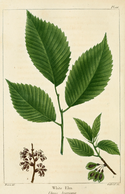
|
NYFA: 5 |
USDA-NN SNA Go Botany VASCAN ARS-GRIN ITIS FNA Images Wikispecies |
Muhl. 1785. U. americana Marshall (i) 1788. U. pubescens Walter 1789. U. americana var. rubra (Muhl.) Aiton 1793. U. rubra Muhl. 1796. U. pendula Willd. 1803. U. fulva Michx. 1809. U. crispa Willd. |
Slippery elm, Red elm Orme rouge, Orme gras |
Native, Secure |

|
NYFA: 5 |
USDA-NN SNA Go Botany VASCAN ARS-GRIN Tropicos Images Wikispecies |
Sarg. 1831. U. racemosa D.Thomas non Borkh. (1800) 1902. U. thomasi(i) Sarg. |
Rock elm, Cork elm, Hickory elm Orme liège, Orme de Thomas |
Native, Threatened |

|
NYFA: 2-3 |
USDA-NN SNA Go Botany VASCAN ARS-GRIN ITIS FNA Images Wikispecies |
| Siberian elm | Introduced from temperate Asia, Moderately invasive, NYIS: 53%[2], CP-5[3] |

|
NYFA: X |
USDA-XX Go Botany Images Wikispecies | |
Huds. |
Wych elm, Scotch elm, Broadleaf elm, Broad-leaved elm, European mountain elm Orme de montagne, Orme montagnard, Orme glabre, Orme blanc, Orme rude |
Introduced from Eurasia, Unk. naturalization |
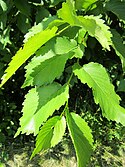
|
NYFA: X |
USDA-XX Go Botany ARS-GRIN Images Wikispecies |
Salisb. 1753. Ulmus campestris L. p.p. (i) 1796. Ulmus procera Salisb. auct. Ulmus minor non Mill.[4] auct. Ulmus carpinifolia non Ruppius ex G.Suckow |
English elm, English cork elm Grand orme, Orme rouge, Orme champêtre |
Introduced from Europe, northern Africa, Not naturalized |

|
NYFA: X |
USDA-XX Go Botany VASCAN ARS-GRIN FNA Tropicos Images Wikispecies |
| Genus Ulmus (excluded taxa) | Elm | N.Y. Status | Images | Distribution | NY NPT |
Mill. 1768. Ulmus minor Mill. |
European field elm | Introduced from Eurasia, northern Africa, N.Y. excluded |

|
NYFA-Excluded |
Images Wikispecies |
Jacq. 1798. Ulmus parvifolia Jacq. 1914. Ulmus sieboldii Daveau |
Lacebark elm, Chinese elm |
Introduced from Asia, Potentially invasive, Excluded |

|
NYFA-Excluded |
USDA-XX Go Botany VASCAN ARS-GRIN Images Wikispecies |
Ulmus glabra × Ulmus procera |
Hybrid of wych elm & English elm |
Introduced from Eurasian parents, N.Y. excluded |

|
NYFA-Excluded |
Images Wikispecies |
| |||||
Family Cannabaceae
[edit | edit source]The Cannabaceae (hemp family)...[1]
|
Celtis
[edit | edit source]| Celtis (hackberry) was formerly included under Ulmaceae (above), but is now more likely to be included under Cannabaceae or in its own family.
|
| Genus Celtis | Hackberry | N.Y. Status | Images | Distribution | NY NPT |
L. 1753. Celtis occidentalis L.
1797. Celtis crassifolia Lam.
1856. C. occidentalis var. crassifolia (Lam.) A. Gray
1919. C. occidentalis var. canina (Raf.) Sarg. |
Northern hackberry, American hackberry, Common hackberry, Beaverwood, Nettletree Micocoulier occidental, Bois inconnu |
Native, CoC: 7, Likely secure FACU Perennial, Tree |

|
NYFA: 4 |
USDA-NN Go Botany VASCAN FNA Tropicos Images Wikispecies |
Nutt. 1814. Celtis pumila Pursh
1818. C. tenuifolia Nutt.
1856. C. occidentalis var. pumila (Pursh) A.Gray
1897. C. georgiana Small
1902. C. pumila var. georgiana Sarg.
1902. C. mississippiensis var. pumila (Pursh) Mack. & Bush
1919. C. pumila var. georgiana Sarg.
1964. C. occidentalis var. georgiana H.E.Ahles
1967. C. tenuifolia var. soperi B.Boivin
1969. C. occidentalis f. pumila (Pursh) F.Seym.
1982. C. occidentalis ssp. georgiana A.E.Murray |
Dwarf hackberry, Upland hackberry, Georgia hackberry Micocoulier rabougri, Micocoulier de Soper, Micocoulier de Géorgie |
Native, CoC: 9, No specimens |

|
NYFA: NU |
USDA-NN VASCAN ARS-GRIN FNA Tropicos BONAP Images Wikispecies |
|
| |||||
Humulus
[edit | edit source] Northeastern hops |
| Genus Humulus | Hops | N.Y. Status | Images | Distribution | NY NPT |
L. var. lupuloides E.Small 1847. Humulus americanus Nutt.
1978. H. lupulus var. lupuloides E.Small
1982. H. lupulus ssp. americanus (Nutt.) Á.&D.Löve
2016. H. lupuloides (E.Small) Tembrock |
Northeastern hops ⓘ
American hop
Common hop ⓘ Houblon lupuloïde |
Native, CoC: 5, Likely secure Perennial, Herb-vine |

|
NYFA: U |
USDA-NN Go Botany VASCAN ARS-GRIN ITIS FNA Tropicos BONAP Images Wikispecies |
L. var. pubescens E.Small 1978. H. lupulus var. pubescens E.Small
2016. H. pubescens (E.Small) Tembrock |
Midwestern hops, Pubescent hop, Common hop |
Native, CoC: 10, Rare Perennial, Herb-vine |

|
NYFA: U |
USDA-N0 ARS-GRIN ITIS FNA Tropicos BONAP Images Wikispecies |
L. var. lupulus 1753. Humulus lupulus L. |
European hop, Common hop Houblon commun, Houblon grimpant |
Introduced from Eurasia, Morocco, Naturalized, NE5[1] Perennial, Herb-vine |

|
NYFA: X |
USDA-XX Go Botany VASCAN ARS-GRIN ITIS FNA Tropicos BONAP Images Wikispecies |
Siebold & Zucc. 1790. Antidesma scandens Lour. 1846. Humulus japonicus Siebold & Zucc. 1935. Humulus scandens (Lour.) Merr. 1988. Humulopsis scandens (Lour.) Grudz. |
Japanese hops, Japanese hop Houblon japonais |
Introduced from eastern Asia, Highly invasive, NYIS: 74%[2], NE4[3] |
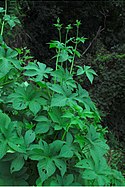
|
NYFA: X |
USDA-XX Go Botany FNA Tropicos BONAP Images Wikispecies |
| |||||
Cannabis
[edit | edit source]| Genus Cannabis | Hemp | N.Y. Status | Images | Distribution | NY NPT |
L. 1753. Cannabis sativa L. 1785. Cannabis indica Lam. 1924. Cannabis ruderalis Janisch. 1976. C. sativassp. indica E.Small & Cronquist |
Hemp, Marijuana, Pot |
Introduced from central Asia |
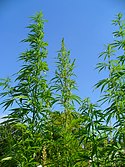
|
NYFA: X |
USDA-XX Go Botany ARS-GRIN ITIS FNA Images Wikispecies |
|
| |||||
Family Moraceae
[edit | edit source]The Moraceae (mulberry or fig family)...[1]
Tribe Moreae
[edit | edit source]Morus
[edit | edit source] red mulberry fruit
|
| Genus Morus | Mulberry | N.Y. Status | Images | Distribution | NY NPT |
L. 1753. Morus rubra L. 1873. Morus rubravar. tomentosa 1873. Morus rubravar. rubra |
Red mulberry, American mulberry Mûrier rouge |
Native, CoC: 8, Secure FACU Perennial, Tree |

|
NYFA: 5 |
USDA-NN Go Botany ARS-GRIN Tropicos Images Wikispecies |
L. 1753. Morus alba L. 1753. Morus tatarica L. 1855. Morus albavar. tatarica |
White mulberry, Russian mulberry, Silkworm mulberry Mûrier blanc |
Introduced from China, Moderately invasive, NYIS: 69%[1] |

|
NYFA: X |
USDA-XX Go Botany ARS-GRIN Tropicos Images Wikispecies |
| Genus Morus (excluded taxa) | Mulberry | N.Y. Status | Images | Distribution | NY NPT |
L. 1753. Morus nigra L. |
Black Mulberry | Introduced from Asia, N.Y. excluded |

|
NYFA-Excluded |
USDA-X0 ARS-GRIN FoC Tropicos Images Wikispecies |
Broussonetia
[edit | edit source]| Genus Broussonetia | Paper mulberry | N.Y. Status | Images | Distribution | NY NPT |
(L.) L'Hér. ex Vent. 1753. Morus papyrifera L. 1799. B. papyrifera (L.) L'Hér. ex Vent. 1891. Papyrius papyriferus (L.) Kuntze |
Paper mulberry, Tapa-cloth-tree Mûrier à papier |
Introduced from Asia (temp & trop), Highly invasive, NYIS Tier: 3, Invasive.org: [8], Naturalized Perennial, Tree |
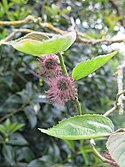
|
NYFA: X |
USDA-XX ARS-GRIN Tropicos BONAP Images Wikispecies |
|
| |||||
Fatoua
[edit | edit source]| Genus Fatoua | Crabweed | N.Y. Status | Images | Distribution | NY NPT |
(Thunb.) Nakai 1784. Urtica japonica Thunb. non L.f. 1782
1784. Urtica villosa Thunb.
1856. Fatoua japonica (Thunb.) Blume nom. illeg.
1927. Fatoua villosa (Thunb.) Nakai |
Mulberry-weed, Hairy crabweed |
Introduced from Japan & Taiwan, Potentially invasive, Invasive.org: [9], Naturalized FAC Annual, Herb-forb |

|
NYFA: Xn |
USDA-XX ARS-GRIN Tropicos Images Wikispecies |
|
| |||||
Tribe Maclureae
[edit | edit source]Maclura
[edit | edit source]| Genus Maclura | Maclura | N.Y. Status | Images | Distribution | NY NPT |
(Raf.) C.K.Schneid. 1817. Ioxylon pomiferum Raf. 1817. Toxylon pomiferum Raf. 1828. Toxylon aurantiacum (Nutt.) Raf. 1906. Maclura pomifera (Raf.) C.K.Schneid. |
Osage-orange, Hedge-apple, Bow-wood, Bodoark Bois d'arc |
Introduced from TX, OK, AR, N. America native, Naturalized Perennial, Shrub, tree |

|
NYFA: X |
USDA-NX Go Botany ARS-GRIN ITIS FNA Tropicos NatureServe BONAP Images Wikispecies |
|
| |||||
Tribe Ficeae
[edit | edit source]Ficus
[edit | edit source]| Genus Ficus | Fig | N.Y. Status | Images | Distribution | NY NPT |
L. 1753. Ficus carica L. |
Common fig, Edible fig |
Introduced, Impersistent |

|
NYFA: Xm |
USDA-XX Images Wikispecies |
|
| |||||
Family Urticaceae
[edit | edit source]The Urticaceae (nettle family)...[1]
Subfamily Urticoideae
[edit | edit source]Tribe Urticeae
[edit | edit source]Laportea
[edit | edit source]| Genus Laportea | Wood nettle | N.Y. Status | Images | Distribution | NY NPT |
(L.) Wedd. 1753. Urtica canadensis L. 1826. Laportea canadensis (L.) Gaudich. 1849. Fleurya canadensis (L.) Benth. 1854. Laportea canadensis (L.) Weddell 1891. Urticastrum divaricatum (L.) Kuntze |
Canada wood nettle, Canada nettle, Wood-nettle, Canadian woodnettle Laportéa du Canada, Ortie des bois, Ortie du Canada |
Native, Secure |

|
NYFA: 5 |
USDA-NN Go Botany VASCAN ARS-GRIN FNA Tropicos Images Wikispecies |
| |||||
Urtica
[edit | edit source]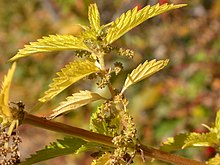 U. gracilis differs from U. dioica in that the native plant is monoecious and has a less dense population of stinging hairs than the European species.
|
| Genus Urtica | Nettle | N.Y. Status | Images | Distribution | NY NPT |
Aiton ssp. gracilis 1789. Urtica gracilis Aiton
1805. Urtica procera Muhl. ex Willd.
1856. Urtica dioica var. procera (Muhl. ex Willd.) Wedd.
1875. Urtica lyallii S.Watson
1889. Urtica californica Greene
1912. Urtica viridis Rydb.
1947. Urtica dioica ssp. gracilis (Aiton) Selander |
American stinging nettle, California nettle, California stinging nettle, California nettle, Slender stalked nettle |
Native, CoC: 2, Secure |

|
NYFA: 5 |
USDA-NN Go Botany VASCAN ARS-GRIN FNA Tropicos Images Wikispecies |
L. ssp. dioica 1753. Urtica dioica L. 1869. Urtica dioicavar. vulgaris |
European stinging nettle Ortie dioïque, Grande ortie |
Introduced, Highly invasive, NYS Tier 5[1], Naturalized, SNA, G5-T5? FAC-FACU Perennial, Herb-forb |

|
NYFA: X |
USDA-XX Go Botany VASCAN Tropicos Images Wikispecies |
L. |
Burning nettle, Dog nettle |
Introduced | 
|
NYFA: X |
USDA-XX Go Botany Images Wikispecies |
Pursh |
Weak nettle, Red nettle, Heart-leaved nettle |
Introduced, US South native |

|
NYFA: X |
USDA-N0 Go Botany-0 Images Wikispecies |
Tribe Lecantheae
[edit | edit source]Pilea
[edit | edit source]|
|
| Genus Pilea | Clearweed | N.Y. Status | Images | Distribution | NY NPT |
(L.) A. Gray var. pumila 1753. Urtica pumila L. 1848. Pilea pumila (L.) A. Gray |
Green-fruited clearweed, Canadian clearweed, Coolwort, Richweed Piléa nain, Pilée naine, Ortie naine, Petite ortie |
Native, CoC: 2, Secure |

|
NYFA: 5 |
USDA-NN Go Botany FNA Tropicos Images Wikispecies |
(Lunell) Rydb. 1843. Adicea pumila Raf. 1913. Adicea fontana Lunell 1913. Adicea opaca Lunell 1931. Pilea fontana (Lunell) Rydb. 1931. Pilea opaca (Lunell) Rydb. |
Black-fruited clearweed, Lesser clearweed, Spring clearweed, Springs clearweed Piléa des fontaines |
Native, CoC: 6, Secure |

|
NYFA: 5 |
USDA-NN Go Botany FNA Tropicos Images Wikispecies |
Pilea fontana × pumila Pilea fontana × Pilea pumila |
Hybrid clearweed | Native, N.Y. excluded |

|
NYFA-Excluded |
Images Wikispecies |
|
| |||||
Tribe Boehmerieae
[edit | edit source]Boehmeria
[edit | edit source] false nettle |
| Genus Boehmeria | False nettle | N.Y. Status | Images | Distribution | NY NPT |
(L.) Sw. 1753. Urtica cylindrica L. 1788. Boehmeria cylindrica (L.) Sw. 1805. Boehmeria cylindrica (L.) Willd. |
False nettle
Smallspike false nettle
Bog hemp Boehméria cylindrique, Fausse ortie cylindrique, Ortie de savanne |
Native, CoC: 7, Secure FACW-OBL Perennial, Herb-forb |

|
NYFA: 5 |
USDA-NN Go Botany VASCAN ARS-GRIN FNA Tropicos Images Wikispecies |
|
| |||||
Tribe Parietarieae
[edit | edit source]Parietaria
[edit | edit source]| Genus Parietaria | Pellitory | N.Y. Status | Images | Distribution | NY NPT |
1806. P. pensylvanica Muhl. ex Willd. 1857. P. debilisvar. pensylvanica 1903. P. obtusa Rydb. ex Small 1912. P. occidentalis Rydb. 1941. Freirea pensylvanica (Muhl. ex Willd.) Jarm. 1950. P. pensylvanicavar. obtusa |
Pennsylvania pellitory, Pennsylvania cucumber plant |
Native, CoC: 2, Secure |

|
NYFA: 5 |
USDA-NN Go Botany ARS-GRIN FNA Tropicos NatureServe BONAP LBJ Images Wikispecies |
L. Parietaria judaica L. Parietaria diffusa |
Spreading pellitory | Introduced from s. Europe, n. Africa, Impersistent |

|
NYFA: X |
USDA-X0 Go Botany FNA Tropicos NatureServe BONAP Images Wikispecies |
|
| |||||




